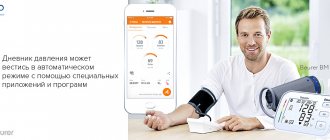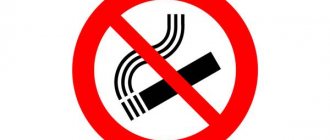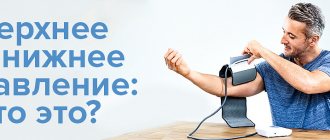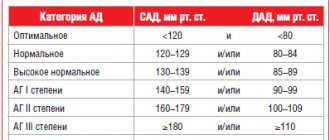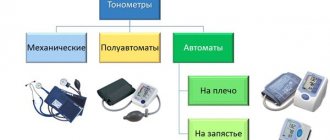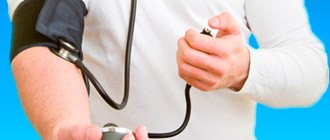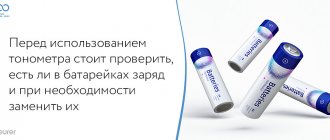Rules and techniques for measuring blood pressure
Rules and techniques for measuring blood pressure. Tonometers for home use.
It should be remembered that currently special attention is paid to measuring blood pressure (BP) at home. It has been proven that self-monitoring of blood pressure and keeping a hypertensive diary help increase the patient’s motivation to treat hypertension, increasing the effectiveness of treatment by 15-20%. When visiting your doctor or specialist consultant, you must bring diary entries with you.
When measuring blood pressure with any tonometer, in order to increase the accuracy of the results, a number of conditions must be observed.
- Blood pressure measurement must be carried out in a sitting position.
- It is necessary to place emphasis on the back of the chair and relax your legs
- measurement is carried out after a 5-minute rest
- The hand on which the measurement is taken should lie on the table and be at the level of the heart.
- the measurement is carried out on the arm on which the pressure is higher
- You should not talk while measuring blood pressure,
- 1-1.5 hours before you need to avoid eating and smoking.
- it is necessary to have a cuff of the required size, which must be placed on the bare shoulder;
- the lower edge of the cuff is located 1-2 cm above the elbow.
- It is recommended to measure blood pressure twice with a break of 3-5 minutes
Measuring blood pressure by the auscultatory method (Korotkoff method) using a phonendoscope and listening to pulsation tones requires compliance with additional rules:
- place the head of the stethophonendoscope in the center of the cubital fossa
- Inflate the cuff quickly enough; in this case, the inflation level should be 20-30 mm Hg higher than “normal” blood pressure
- after opening the tap, the air should be released at a speed of 2-3 mmHg per second
- record the appearance of the first Korotkoff sound, which indicates systolic blood pressure
- record the disappearance of Korotkoff sounds, which indicates diastolic blood pressure
What tonometer is recommended to measure blood pressure at home?
European recommendations for the treatment of hypertension and the Recommendations of the Russian Society of Therapists “Prevention of Chronic Non-Infectious Diseases” (2013) recommend “... measuring blood pressure in patients using an automatic method using various models of tonometers.” Firstly, it is precisely such devices that provide high measurement accuracy. Secondly, due to the convenience and simplicity of the procedure for measuring blood pressure, only automatic blood pressure monitors contribute to high motivation and commitment of the patient to constantly measure blood pressure and keep a hypertensive diary.
So, in particular, measuring blood pressure by the auscultatory method (Korotkoff method) using a phonendoscope and listening to pulsation tones requires good hearing, experience and coordination of the “hands-eyes-ears” system. In addition, following the technique of inflating and deflating the cuff required for high accuracy results makes the procedure difficult for a person who does not have the skills to do this. Failure to comply with these rules leads to an error in the results when using mechanical tonometers of 10-15 mm Hg. Such an error is significant and can affect the treatment and prognosis of the disease. The use of a bulb for self-pumping air is undoubtedly associated with muscle tension in the arm, which also leads to an overestimation of blood pressure values. Therefore, the use of semi-automatic tonometers that have an oscillometric sensor, but retain a bulb for self-inflating air, is unjustified.
The accuracy of automatic blood pressure monitors has been repeatedly assessed over the past decades in accordance with stringent international criteria for the standardization of medical devices. This was the basis for recommending the use of automatic tonometers at home.
OMRON tonometer is the No. 1 tonometer for measuring blood pressure at home.
OMRON tonometers have all the necessary characteristics that make them the No. 1 device for measuring blood pressure at home. A fan-shaped cuff of a universal size of 22-42 cm, following the natural contour of the arm, evenly distributes the air, making the measurement painless and accurate. The intelligent Intellisense system pumps air immediately, adjusting to the patient - 20-30 mm above systolic blood pressure, making the measurement convenient, fast and accurate.
It must be emphasized that many models of OMRON automatic tonometers have sensors for cuff position, arm movement, and arrhythmia indicators. At the same time, only the OMRON model M6 tonometer is capable of most accurately measuring blood pressure during atrial fibrillation, which is a significant difference between this model and other tonometers, including those from other manufacturers.
OMRON, which produces highly sensitive sensors used in a wide variety of equipment, has been producing blood pressure monitors for 40 years, which are used in medicine in different countries. These characteristics have made OMRON tonometers the leader in sales in Russia over the past few years.
Based on studies conducted by American and European experts, OMRON automatic blood pressure monitors have been assigned a high accuracy class (A) (European Society of Hypertension, 2013).
OMRON wrist blood pressure monitors are also recommended for use. These devices are primarily indicated for people with large shoulder volume, as well as for those who often take the tonometer on the road. Currently, there are no age restrictions on the use of wrist tonometers. Important! To accurately measure blood pressure, the cuff sensor must be positioned as accurately as possible at the level of the patient's heart.
It is important to know!
When measuring blood pressure with any tonometer, sequential blood pressure measurements with an interval of 2-3 minutes will give different values. The value of blood pressure, like all other parameters of the body, is not constant and is within the limits of physiological fluctuations. Differences in tonometer readings should not be regarded as manifestations of inaccuracy or malfunction of the devices.
Medical significance of the oscillometric method of measuring blood pressure
Unfortunately, these so-called “major vascular diseases” are very common in Western European countries.
In the United States, the annual number of cases of myocardial infarction reaches 900 thousand, in the UK - 225 thousand;
in Germany - 275 thousand people suffer from this acute coronary disease. 40 - 50% of all these patients die during the initial 4 weeks of the post-infarction period. About 420 thousand patients in the United States, about 100 thousand in the UK and about 125 thousand patients in Germany suffer from stroke. 50% of them cannot continue their professional activities due to brain damage. Stroke and myocardial infarction account for 45% of all deaths in Western Europe. To prevent many diseases and maintain your health, along with such measures as a healthy lifestyle, balanced diet, control of cholesterol levels in the blood, quitting smoking, it is necessary to prevent an increase in blood pressure for as long a period of time as possible.
High blood pressure, however, is quite common. In developed countries, the overall prevalence of this disease reaches 20%. In the United States, for example, 56 million people suffer from this disease. The corresponding figures for Great Britain are 13 million, and for Germany about 16 million. Fortunately, modern medicine offers a wide range of therapeutic measures, including diet, physical activity, and pharmaceutical interventions. Any therapy, however, requires, first of all, a correct diagnosis of arterial hypertension. Only a doctor can make a correct diagnosis. Unfortunately, results obtained in the doctor's office alone are not sufficient to accurately diagnose hypertension: First, patients in the doctor's office are often subject to the so-called "white coat effect", which leads to an artificial increase in the patient's blood pressure level. Secondly, working patients do not have the opportunity to visit a doctor frequently. Therefore, when assessing blood pressure levels during the day, patients need to measure their blood pressure themselves. Measurements can be taken both at the workplace and at home. Measurement data should be entered into a “measurement diary” and presented to the doctor during visits. Today, there are two methods for measuring blood pressure: using automatic tonometers that measure pressure using the oscillometric method and using devices that measure pressure using the auscultatory method. The auscultatory method of measuring blood pressure, also called the Riva-Rocci method, is based on the detection of arterial pulsation sounds, heard as the blood tone passes under a cuff wrapped around the patient's shoulder. Most auscultatory devices are hand-held devices, that is, patients use a stethoscope to listen to the sounds of the pulse and determine the systolic and diastolic pressure based on the nature of the sound. This method only works well if patients are properly trained and have the appropriate experience. Unfortunately, many patients suffering from arterial hypertension are elderly. They often have reduced hearing and are unable to properly use hand-held auscultation devices. There are several automatic auscultatory tonometers on the market. Their disadvantage is their high sensitivity to noise interference. The microphone, which is part of these devices, perceives various sound signals that interfere with correct measurements. More than 10 years have passed since the oscillometric measurement method began to be used in devices for measuring blood pressure. This technique allows you to assess the level of arterial pressure using a cuff placed on any limb. When measuring at home, pressure is measured either at the shoulder or at the wrist. Shoulder devices show more accurate results. There is a camera inside the cuff that detects pulse changes in the flow of blood passing just under the cuff. All changes in pressure are recorded during the measurement. The oscillometric method has two main advantages:
- patients do not need to have the skills to interpret the nature of pulse changes
- patients do not have to engage in self-assessment of sound signals
In this case, it is important to observe some basic conditions: take measurements only at rest, any movements should be excluded, and the cuff should be at the level of the heart. No special skills are required for these measurements. Today, the buyer is offered a wide range of oscillometric instruments. The accuracy of these devices is very high, but it is not the same among different manufacturers, which is due to the design features of the devices and the use of technology in their production.
This refers to the degree of possibility:
- suppression of extraneous noise
- correct interpretation of heart rate changes
- low heart rate measurements
- measuring very low or very high pressure
Due to incorrect behavior of patients during measurement, in particular due to lack of rest, the result of one measurement differs from another. Such errors are not a technology error; they are caused by the instability of the pressure level itself. Since the pressure level changes dynamically, one-time measurements should not be practiced. To find out the true level of pressure, it is necessary to take a series of repeated measurements. It is very important that patients undergoing treatment for high blood pressure prepare materials with measurement data for their treating physicians (keeping measurement diaries). They play a significant role in prescribing further treatment.
Conclusion: Oscillometric blood pressure measurement technology is reliable for accurately assessing blood pressure levels in patients suffering from hypotension or hypertension. Despite some technical and psychological limitations, this technology has important medical significance and is unique. Klaus Forstner
Doctor, MD cd Dipl.-Ing. Tamm, May 16th, 2002
